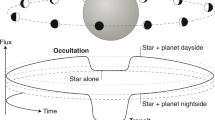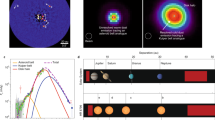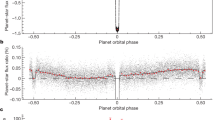Abstract
In its 16 years of scientific measurements, the Spitzer Space Telescope performed a number of groundbreaking and key infrared measurements of Solar System objects near and far. In this second of two Review Articles, we describe results from Spitzer observations of asteroids, dust rings and planets that provide new insight into the formation and evolution of our Solar System. The key Spitzer results presented here can be grouped into three broad classes: characterizing the physical properties of asteroids, notably including a large survey of near-Earth objects; detection and characterization of several dust/debris disks in the Solar System; and comprehensive characterization of ice giant (Uranus and Neptune) atmospheres. Many of these observations provide critical foundations for future infrared space-based observations.
This is a preview of subscription content, access via your institution
Access options
Access Nature and 54 other Nature Portfolio journals
Get Nature+, our best-value online-access subscription
$29.99 / 30 days
cancel any time
Subscribe to this journal
Receive 12 digital issues and online access to articles
$119.00 per year
only $9.92 per issue
Buy this article
- Purchase on Springer Link
- Instant access to full article PDF
Prices may be subject to local taxes which are calculated during checkout






Similar content being viewed by others
References
Cruikshank, D. P., Werner, M. W. & Backman, D. E. SIRTF: capabilities for planetary science. Adv. Space Res. 12, 187–193 (1992).
Cruikshank, D. P. & Werner, M. W. in Planets Beyond the Solar System and the Next Generation of Space Missions (ed. Soderblom, D.) 223–244 (Astronomical Society of the Pacific, 1997).
List of Spitzer Approved Programs (IRSA, 2020); https://go.nature.com/362LqBB
Lisse, C. et al. Spitzer’s Solar System studies of comets, centaurs and Kuiper belt objects. Nat. Astron. https://doi.org/10.1038/s41550-020-01219-6 (2020).
Granvik, M. et al. Debiased orbit and absolute-magnitude distributions for near-Earth objects. Icarus 312, 181–207 (2018).
Harris, A. W. A thermal model for near-Earth asteroids. Icarus 131, 291–301 (1998).
Harris, A. W. et al. ExploreNEOs. II: the accuracy of the warm Spitzer near-Earth object survey. Astron. J. 141, 75 (2011).
Trilling, D. E. et al. NEOSurvey 1: initial results from the warm Spitzer exploration science survey of near-Earth object properties. Astron. J. 152, 172 (2016).
Mommert, M. et al. ExploreNEOs. VIII. Dormant short-period comets in the near-Earth asteroid population. Astron. J. 150, 106 (2015).
Gustafsson, A. et al. Spitzer albedos of near-Earth objects. Astron. J. 158, 67 (2019).
Hora, J. L. et al. Infrared light curves of near-Earth objects. Astrophys. J. Suppl. 238, 22 (2018).
McNeill, A., Hora, J. L., Gustafsson, A., Trilling, D. E. & Mommert, M. Constraining the shape distribution of near-Earth objects from partial light curves. Astron. J. 157, 164 (2019).
Mommert, M. et al. The discovery of cometary activity in near-Earth asteroid (3552) Don Quixote. Astrophys. J. 781, 25 (2014).
Mommert, M. et al. Recurrent cometary activity in near-Earth object (3552) Don Quixote. Planet. Sci. J. 1, 12 (2020).
Mommert, M. et al. Constraining the physical properties of near-Earth object 2009 BD. Astrophys. J. Lett. 786, 148 (2014).
Mommert, M. et al. Physical properties of near-Earth asteroid 2011 MD. Astrophys. J. Lett. 789, L22 (2014).
Emery, J. P., Cruikshank, D. P. T. & van Cleve, J. Thermal emission spectroscopy (5.2–38 μm) of three Trojan asteroids with the Spitzer Space Telescope: detection of fine-grained silicates. Icarus 182, 496–512 (2006).
DellaGiustina, D. N. et al. Properties of rubble-pile asteroid (101955) Bennu from OSIRIS-REx imaging and thermal analysis. Nat. Astron. 3, 341–351 (2019).
Rozitis, B. et al. Asteroid (101955) Bennu’s weak boulders and thermally anomalous equator. Sci. Adv. (in the press).
Campins, H. et al. Spitzer observations of spacecraft target 162173 (1999 JU3). Astron. Astrophys. 503, L17–L20 (2009).
Müller, T. G. et al. Hayabusa-2 mission target asteroid 162173 Ryugu (1999 JU3): searching for the object’s spin-axis orientation. Astron. Astrophys. 599, A103 (2017).
Sugita, S. et al. The geomorphology, color, and thermal properties of Ryugu: implications for parent-body processes. Science 364, eaaw0422 (2019).
Mueller, M. et al. ExploreNEOs. III. Physical characterization of 65 potential spacecraft target asteroids. Astron. J. 141, 109 (2011).
Harris, A. W., Mueller, M., Lisse, C. M. & Cheng, A. F. A survey of Karin cluster asteroids with the Spitzer Space Telescope. Icarus 199, 86–96 (2009).
Nesvorný, D. et al. Karin cluster formation by asteroid impact. Icarus 183, 296–311 (2006).
Licandro, J. et al. 5–14 μm Spitzer spectra of Themis family asteroids. Astron. Astrophys. 537, A73 (2012).
Landsman, Z. A. et al. The Veritas and Themis asteroid families: 5–14 μm spectra with the Spitzer Space Telescope. Icarus 269, 62–74 (2016).
Ryan, E. L. & Woodward, C. E. Albedos of small Hilda group asteroids as revealed by Spitzer. Astron. J. 141, 186 (2011).
Barucci, M. A. et al. Asteroids 2867 Steins and 21 Lutetia: surface composition from far infrared observations with the Spitzer Space Telescope. Astron. Astrophys. 477, 665–670 (2008).
Houck, J. R. et al. The Infrared Spectrograph (IRS) on the Spitzer Space Telescope. Astrophys. J. Suppl. 154, 18–24 (2004).
Ryan, E. L. et al. The kilometer-sized main belt asteroid population revealed by Spitzer. Astron. Astrophys. 578, A42 (2015).
Morbidelli, A., Levison, H. F., Tsiganis, K. & Gomes, R. Chaotic capture of Jupiter’s Trojan asteroids in the early Solar System. Nature 435, 462–465 (2005).
Mueller, M. et al. Eclipsing binary Trojan asteroid Patroclus: thermal inertia from Spitzer observations. Icarus 205, 505–515 (2010).
Burns, J. A., Lamy, P. L. & Soter, S. Radiation forces on small particles in the Solar System. Icarus 40, 1–48 (1979).
Szalay, J. R. et al. The near-Sun dust environment: initial observations from the Parker Solar Probe. Astrophys. J. Suppl. 246, 27 (2020).
Dermott, S. F., Jayaraman, S., Xu, Y. L., Gustafson, B. A. S. & Liou, J. C. A circumsolar ring of asteroidal dust in resonant lock with the Earth. Nature 369, 719–723 (1994).
Reach, W. T. Structure of the Earth’s circumsolar dust ring. Icarus 208, 848–850 (2010).
Nesvorný, D. et al. Candidates for asteroid dust trails. Astron. J. 132, 582–595 (2006).
Nesvorný, D. et al. Origin of the near-ecliptic circumsolar dust band. Astrophys. J. Lett. 679, L143–L146 (2008).
Verbiscer, A., Skrutskie, M. F. & Hamilton, D. P. Saturn’s largest ring. Nature 461, 1098–1100 (2009).
Hamilton, D. P., Skrutskie, M. F., Verbiscer, A. J. & Masci, F. J. Small particles dominate Saturn’s Phoebe ring to surprisingly large distances. Nature 522, 185–187 (2015).
Wright, E. L. et al. The Wide-field Infrared Survey Explorer (WISE): mission description and initial on-orbit performance. Astrophys. J. 140, 1868–1881 (2010).
Soter, S. Brightness of Iapetus. IAU Colloq. 28 (1974).
Burns, J. A., Hamilton, D. P., Mignard, F. & Soter, S. in Astronomical Society of the Pacific Conference Series Vol. 104 (eds Gustafson, B. A. S. & Hanner, M. S.) 179–182 (ASP, 1996).
Squyres, S. W. & Sagan, C. Albedo asymmetry of Iapetus. Nature 303, 782–785 (1983).
Tamayo, D., Burns, J. A., Hamilton, D. P. & Hedman, M. M. Finding the trigger to Iapetus’ odd global albedo pattern: dynamics of dust from Saturn’s irregular satellites. Icarus 215, 260–278 (2011).
Clark, R. N. et al. The surface composition of Iapetus: mapping results from Cassini VIMS. Icarus 218, 831–860 (2012).
Dalle Ore, C. M., Cruikshank, D. P. & Clark, R. N. Infrared spectroscopic characterization of the low-albedo materials on Iapetus. Icarus 221, 735–743 (2012).
Burgdorf, M., Orton, G., van Cleve, J., Meadows, V. & Houck, J. Detection of new hydrocarbons in Uranus’ atmosphere by infrared spectroscopy. Icarus 184, 634–637 (2006).
Orton, G. S. et al. Mid-infrared spectroscopy of Uranus from the Spitzer infrared spectrometer: 2. Determination of the mean composition of the upper troposphere and stratosphere. Icarus 243, 471–493 (2014).
Orton, G. S. et al. Mid-infrared spectroscopy of Uranus from the Spitzer infrared spectrometer: 1. Determination of the mean temperature structure of the upper troposphere and stratosphere. Icarus 243, 494–513 (2014).
Herbert, F. et al. The upper atmosphere of Uranus: EUV occultations observed by Voyager 2. J. Geophys. Res. 92, 15093–15109 (1987).
Stevens, M. H., Strobel, D. F. & Herbert, F. H. An analysis of the Voyager 2 Ultraviolet Spectrometer occultation data at Uranus: inferring heat sources and model atmospheres. Icarus 101, 45–63 (1993).
Orton, G. S. et al. The spectra of Uranus and Neptune at 8–14 and 17–23 μm. Icarus 70, 1–12 (1987).
Conrath, B. J. et al. Infrared observations of the Neptunian system. Science 246, 1454–1459 (1989).
Bezard, B., Romani, P. N., Conrath, B. J. & Maguire, W. C. Hydrocarbons in Neptune’s stratosphere from Voyager infrared observations. J. Geophys. Res. 96, 18961–18975 (1991).
Bishop, J. et al. in Neptune and Triton (ed. Cruikshank, D. P.) 427–487 (Univ. of Arizona Press, 1995).
Marten, A. et al. First observations of CO and HCN on Neptune and Uranus at millimeter wavelengths and their implications for atmospheric chemistry. Astrophys. J. 406, 285–297 (1993).
Schulz, B. et al. Detection of C2H4 in Neptune from ISO/PHT-S observations. Astron. Astrophys. 350, L13–L17 (1999).
Bezard, B., Romani, P. N., Feuchtgruber, H. & Encrenaz, T. Detection of the methyl radical on Neptune. Astrophys. J. 515, 868–872 (1999).
Moses, J. I., Fletcher, L. N., Greathouse, T. K., Orton, G. S. & Hue, V. Seasonal stratospheric photochemistry on Uranus and Neptune. Icarus 307, 124–145 (2018).
Moses, J. I. et al. Photochemistry and diffusion in Jupiter’s stratosphere: constraints from ISO observations and comparisons with other giant planets. J. Geophys. Res. 110, E08001 (2005).
Meadows, V. S. et al. First Spitzer observations of Neptune: detection of new hydrocarbons. Icarus 197, 585–589 (2008).
Fletcher, L. N., Gustafsson, M. & Orton, G. S. Hydrogen dimers in giant-planet infrared spectra. Astrophys. J. Suppl. 235, 24 (2018).
Spitzer Heritage Archive (IRSA, 2020); https://irsa.ipac.caltech.edu/data/SPITZER/docs/spitzerdataarchives/
Kelley, M. S. P., Woodward, C. E., Gehrz, R. D., Reach, W. T. & Harker, D. E. Mid-infrared spectra of comet nuclei. Icarus 284, 344–358 (2017).
Acknowledgements
The authors would like to thank the Spitzer project, without which none of the science described above would have been possible. The dedication, competence and excellence with which the staff of the Spitzer Science Center carried out their mission, and in particular observations of Solar System objects, is greatly appreciated, and has produced a scientific foundation that will last for decades. This work is based on observations made with the Spitzer Space Telescope, which was operated by the Jet Propulsion Laboratory, California Institute of Technology, under a contract with NASA. Support for this work was provided by NASA, in some cases through an award issued by JPL/Caltech. Y.F. acknowledges support of a SIRTF/Spitzer Fellowship.
Author information
Authors and Affiliations
Contributions
D.E.T., C.L., D.P.C., Y.F., L.N.F., D.P.H., H.B.H., A.W.H., M.M., G.S.O., Y.J.P., W.R., M.S., N.R.G., and A.V. carried out scientific analysis and wrote parts of this paper. J.P.E. contributed scientific analysis that is presented in this paper.
Corresponding author
Ethics declarations
Competing interests
The authors declare no competing interests.
Additional information
Peer review information Nature Astronomy thanks Nancy Chanover and Elisabetta Dotto for their contribution to the peer review of this work.
Publisher’s note Springer Nature remains neutral with regard to jurisdictional claims in published maps and institutional affiliations.
Rights and permissions
About this article
Cite this article
Trilling, D.E., Lisse, C., Cruikshank, D.P. et al. Spitzer’s Solar System studies of asteroids, planets and the zodiacal cloud. Nat Astron 4, 940–946 (2020). https://doi.org/10.1038/s41550-020-01221-y
Received:
Accepted:
Published:
Issue Date:
DOI: https://doi.org/10.1038/s41550-020-01221-y
This article is cited by
-
Spitzer’s Solar System studies of comets, centaurs and Kuiper belt objects
Nature Astronomy (2020)



